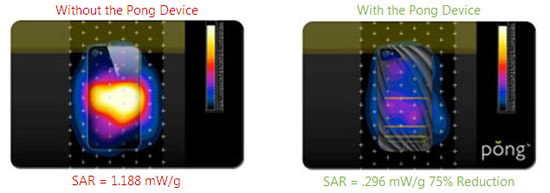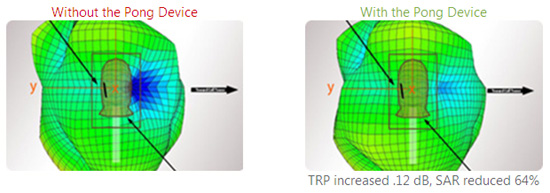Since there are still health concerns about the long-term exposure to cell phone radiation, most consumers try to avoid unnecessary exposure using headsets or other Bluetooth devices (at least when convenient). Yet we also want a powerful cell phone with maximum signal strength for quality voice and data. While there are lots of companies offering solutions to protect consumers from cell phone radiation, few have reliable measured data that prove their product works.
I recently came across Pong cases that not only reduces a person's exposure to radiation, but also optimizes the cell phone's signal strength. I found the following information on their web site which is very interesting:
When you hold your cell phone to your ear, you are absorbing between 48 to 68% of the near field energy radiated by the phone according to Pong. It is this radiation that causes concerns among physicians, scientists, and lawmakers who believe this exposure could be a health hazard. The near field radiation of the iPhone 4/4S can be seen as a white "hot spot" in the picture below on the left. On the right, using Pong, near field energy has been directed away from the user.

The above pictures are of actual laboratory results for SAR on an iPhone 4/4S. On the left, the near field energy emanating from the antenna is easily seen (SAR=1.188 mW/g) . Following application of a Pong device, the vast majority of the near field energy has been diffracted away from the user (SAR=.296 mW/g). SAR is reduced by 75% in this example.
In the US, the SAR limit is 1.6 W/kg (watts/kilogram), averaged over a volume of 1 gram of tissue. In general, the lower the SAR, the better the chances your phone is not a potential health hazard. Accoding to Pong, FCC certified laboratories have confirmed that their technology reduces the amount of radiation absorbed into the user's head by up to 95%, as measured on the SAR scale.
But how does this affect the cell phone signal. As a lot of the signal is absorbed by your head, the remainder of the signal which is not absorbed diffracts around the user and communicates with the cell tower including the energy that is transmitted away from your head. The energy that continues toward the cell tower is measured as Far Field energy. Pong redirects the energy away from the user's head where it can then propagate as far field energy toward the cell tower.

The above 3D plots were developed from actual tests conducted at CETECOM, an independent, FCC certified test facility. The phone under test was the iPhone 3GS. The plot on the left shows the actual reduction of far field energy (dark blue "dent") caused by the absorption of radiation by the head. Once a Pong device is placed on the phone, the far field energy deficit (light blue) improves from the energy which has been redirected away from the user and propagated to the side of the head opposite the phone. The resulting increase in far field energy enhances the omnidirectional capabilities of your phone and may actually improve your signal.
We contacted the company representatives and they have agreed to contribute an article for a future issue of Microwave Journal so more to come.

